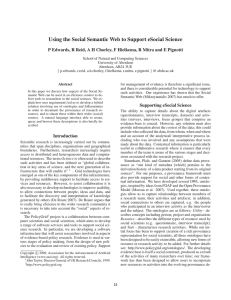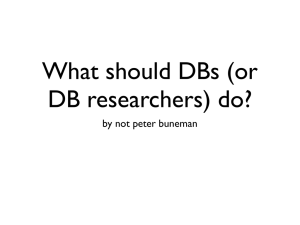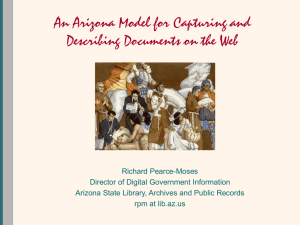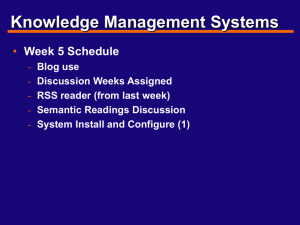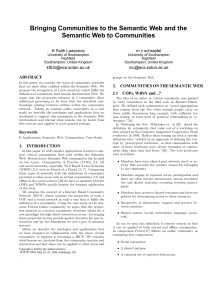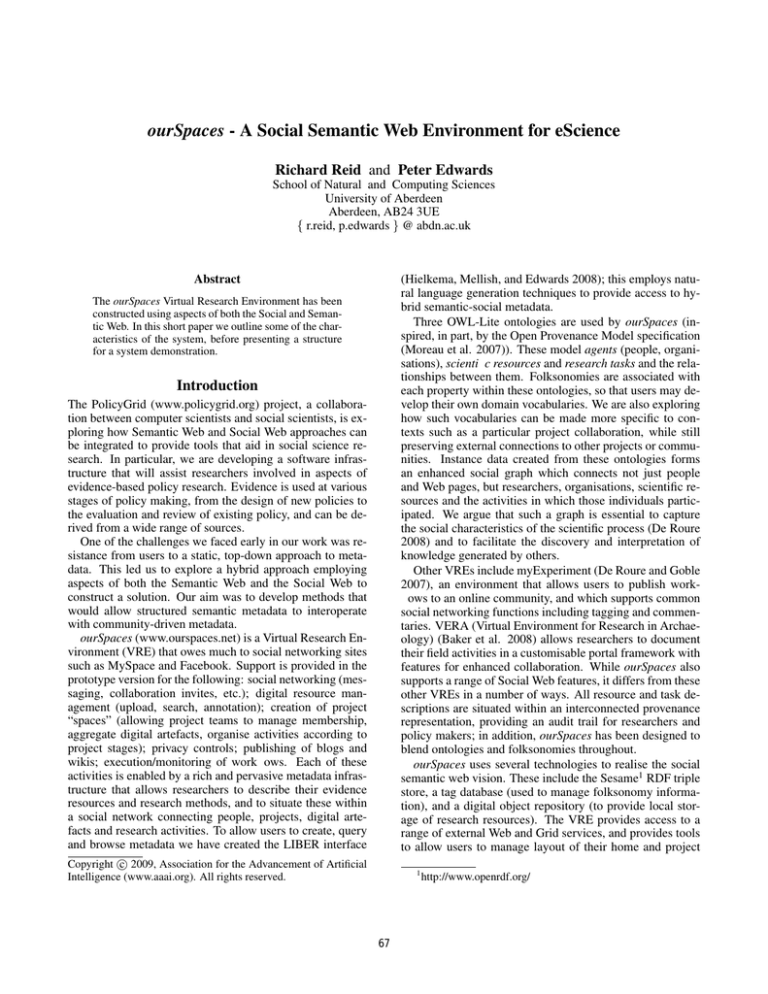
ourSpaces - A Social Semantic Web Environment for eScience
Richard Reid and Peter Edwards
School of Natural and Computing Sciences
University of Aberdeen
Aberdeen, AB24 3UE
{ r.reid, p.edwards } @ abdn.ac.uk
(Hielkema, Mellish, and Edwards 2008); this employs natural language generation techniques to provide access to hybrid semantic-social metadata.
Three OWL-Lite ontologies are used by ourSpaces (inspired, in part, by the Open Provenance Model specification
(Moreau et al. 2007)). These model agents (people, organisations), scienti c resources and research tasks and the relationships between them. Folksonomies are associated with
each property within these ontologies, so that users may develop their own domain vocabularies. We are also exploring
how such vocabularies can be made more specific to contexts such as a particular project collaboration, while still
preserving external connections to other projects or communities. Instance data created from these ontologies forms
an enhanced social graph which connects not just people
and Web pages, but researchers, organisations, scientific resources and the activities in which those individuals participated. We argue that such a graph is essential to capture
the social characteristics of the scientific process (De Roure
2008) and to facilitate the discovery and interpretation of
knowledge generated by others.
Other VREs include myExperiment (De Roure and Goble
2007), an environment that allows users to publish workows to an online community, and which supports common
social networking functions including tagging and commentaries. VERA (Virtual Environment for Research in Archaeology) (Baker et al. 2008) allows researchers to document
their field activities in a customisable portal framework with
features for enhanced collaboration. While ourSpaces also
supports a range of Social Web features, it differs from these
other VREs in a number of ways. All resource and task descriptions are situated within an interconnected provenance
representation, providing an audit trail for researchers and
policy makers; in addition, ourSpaces has been designed to
blend ontologies and folksonomies throughout.
ourSpaces uses several technologies to realise the social
semantic web vision. These include the Sesame1 RDF triple
store, a tag database (used to manage folksonomy information), and a digital object repository (to provide local storage of research resources). The VRE provides access to a
range of external Web and Grid services, and provides tools
to allow users to manage layout of their home and project
Abstract
The ourSpaces Virtual Research Environment has been
constructed using aspects of both the Social and Semantic Web. In this short paper we outline some of the characteristics of the system, before presenting a structure
for a system demonstration.
Introduction
The PolicyGrid (www.policygrid.org) project, a collaboration between computer scientists and social scientists, is exploring how Semantic Web and Social Web approaches can
be integrated to provide tools that aid in social science research. In particular, we are developing a software infrastructure that will assist researchers involved in aspects of
evidence-based policy research. Evidence is used at various
stages of policy making, from the design of new policies to
the evaluation and review of existing policy, and can be derived from a wide range of sources.
One of the challenges we faced early in our work was resistance from users to a static, top-down approach to metadata. This led us to explore a hybrid approach employing
aspects of both the Semantic Web and the Social Web to
construct a solution. Our aim was to develop methods that
would allow structured semantic metadata to interoperate
with community-driven metadata.
ourSpaces (www.ourspaces.net) is a Virtual Research Environment (VRE) that owes much to social networking sites
such as MySpace and Facebook. Support is provided in the
prototype version for the following: social networking (messaging, collaboration invites, etc.); digital resource management (upload, search, annotation); creation of project
“spaces” (allowing project teams to manage membership,
aggregate digital artefacts, organise activities according to
project stages); privacy controls; publishing of blogs and
wikis; execution/monitoring of work ows. Each of these
activities is enabled by a rich and pervasive metadata infrastructure that allows researchers to describe their evidence
resources and research methods, and to situate these within
a social network connecting people, projects, digital artefacts and research activities. To allow users to create, query
and browse metadata we have created the LIBER interface
c 2009, Association for the Advancement of Artificial
Copyright Intelligence (www.aaai.org). All rights reserved.
1
67
http://www.openrdf.org/
Figure 1: A user’s home page in the ourSpaces VRE.
Acknowledgements
pages by selecting from a range of components, including
tag clouds and timeline views.
The authors acknowledge financial support provided by the
UK Economic and Social Research Council (ESRC) under
the eSocial Science programme; grant reference RES-14925-1027.
Demonstration Content
During the demonstration, we will present the ourSpaces
prototype and will perform a walkthrough of its various features as follows:
References
Baker, M.; Fisher, C.; O’Riordan, E.; Grove, M.; Fulford,
M.; Warwick, C.; Terras, M.; and Rains, M. 2008. VERA:
Virtual Research Environment in Archaeology. In Proceedings of the Fourth International Conference on e-Social
Science.
De Roure, D., and Goble, C. 2007. myExperiment - A Web
2.0 Virtual Research Environment. In International Workshop on Virtual Research Environments and Collaborative
Work Environments.
De Roure, D. 2008. The New e-Science Presentation.
http://www.slideshare.net/dder/the-new-sciencebangalore-edition.
Hielkema, F.; Mellish, C.; and Edwards, P. 2008. Evaluating an Ontology-Driven WYSIWYM Interface. In Proceedings of the Fifth International Conference on Natural
Language Generation.
Moreau, L.; Plale, B.; Miles, S.; Goble, C.; Missier, P.;
Barga, R.; Simmhan, Y.; Futrelle, J.; McGrath, R.; Myers, J.; Paulson, P.; Bowers, S.; Ludaescher, B.; Kwasnikowska, N.; Ellkvist, T.; Freire, J.; and Groth, P. 2007.
The Open Provenance Model. Technical Report, University of Southampton.
A user’s personal home page (Figure 1) and the associated
customisation features including component selection and
appearance; this will be followed by a brief demonstration
of the standard Social Web features (such as contact lists,
messaging and tagging).
Space browsing and creation features, including creation
of a new project space.
Resource management facilities, including resource upload and creation of descriptions using the LIBER metadata interface which exists within ourSpaces. This part
of the demonstration will also illustrate how lightweight
metadata (in this case, folksonomies) are integrated with
ontologies.
The enhanced social graph and provenance. Methods for
creating and visualising the interconnected graph of researchers, resource and task descriptions, and the associated digital artefacts will be presented; these include a
timeline component.
Multiple approaches to searching and navigation; users
can search via tag clouds, keywords or using the LIBER
natural language interface.
68



